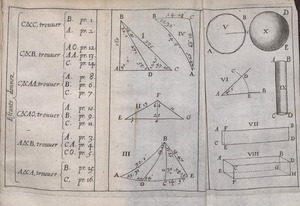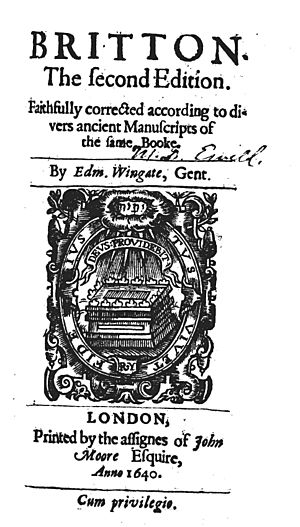Edmund Wingate facts for kids
Edmund Wingate (born 1596, died 1656) was an English writer. He wrote about math and law. He was one of the first people to publish ideas about the slide rule in the 1620s. He also wrote many popular books that explained things clearly. Later in his life, he became a Member of Parliament.
Contents
Wingate's Early Life and Education
Edmund Wingate was born in 1596 in Flamborough, Yorkshire. His father was Roger Wingate. Edmund was baptized on June 11, 1596.
He went to The Queen's College, Oxford in 1610. He earned his first degree in 1614. After that, he joined Gray's Inn in London. This was a place where people studied law.
Time in France and the Slide Rule
Before 1624, Edmund Wingate moved to Paris, France. There, he taught English to Princess Henrietta Maria. She later became the Queen of England.
While in England, Wingate learned about a new math tool. It was called the "rule of proportion." Today, we know it as a type of logarithmic scale or slide rule. It was invented by Edmund Gunter.
Wingate shared this new tool with mathematicians in Paris. He quickly published a book about it. He wanted to make sure he was known as the first to share this important invention in France.
Return to England and Political Life
When the First English Civil War began, Wingate was back in England. He supported the Parliament against the King. He became a justice of the peace for Bedfordshire. This meant he helped keep law and order in the area.
He lived in Woodend at this time. Later, he became friends with Oliver Cromwell. Cromwell was a very important leader during this period.
In 1654, Wingate was elected to Parliament. He represented Bedfordshire. He died in London in 1656 and was buried on December 13.
Edmund Wingate's Published Works
Edmund Wingate wrote many books. They covered topics like math and law. Here are some of his important publications:
- L'usage de la règle de proportion en arithmétique (Paris, 1624): This was his first book about the slide rule. It was written in French.
- The Use of the Rule of Proportion (London, 1626): This was the English version of his slide rule book. It was very popular and had many new editions.
- Arithmetique Logarithmetique (Paris, 1626): This book was about logarithms. Logarithms are a way to make big calculations easier.
- Of Natural and Artificiall Arithmetique (London, 1630): This book had two parts. It taught about basic math and also about using logarithms. Later, it was made easier to understand and called Arithmetique made easie. This book was used for many years.
- Statuta Pacis (London, 1641): This book was a guide for Justices of the Peace. It explained the laws they needed to know.
- An Exact Abridgment of all the Statutes in force and use from the beginning of Magna Carta (London, 1642): This was a summary of all the laws in England. It was a very useful book for lawyers and judges.
- Justice Revived (London, 1644): Another book explaining the job of a Justice of the Peace.
- Ludus Mathematicus (London, 1654): This book described a special math tool.
- The Body of the Common Law of England (London, 1655): This book explained the main laws of England.
- The Clarks Tutor for Arithmetick and Writing (London, 1671): This book was published after his death. It taught people about math and writing.
Wingate also edited other important books. One was Britton (1640), an old law book. He corrected some parts of it to make it more accurate.
Wingate's Family Life
Edmund Wingate married Elizabeth Button in 1628. They had five sons and two daughters together.



